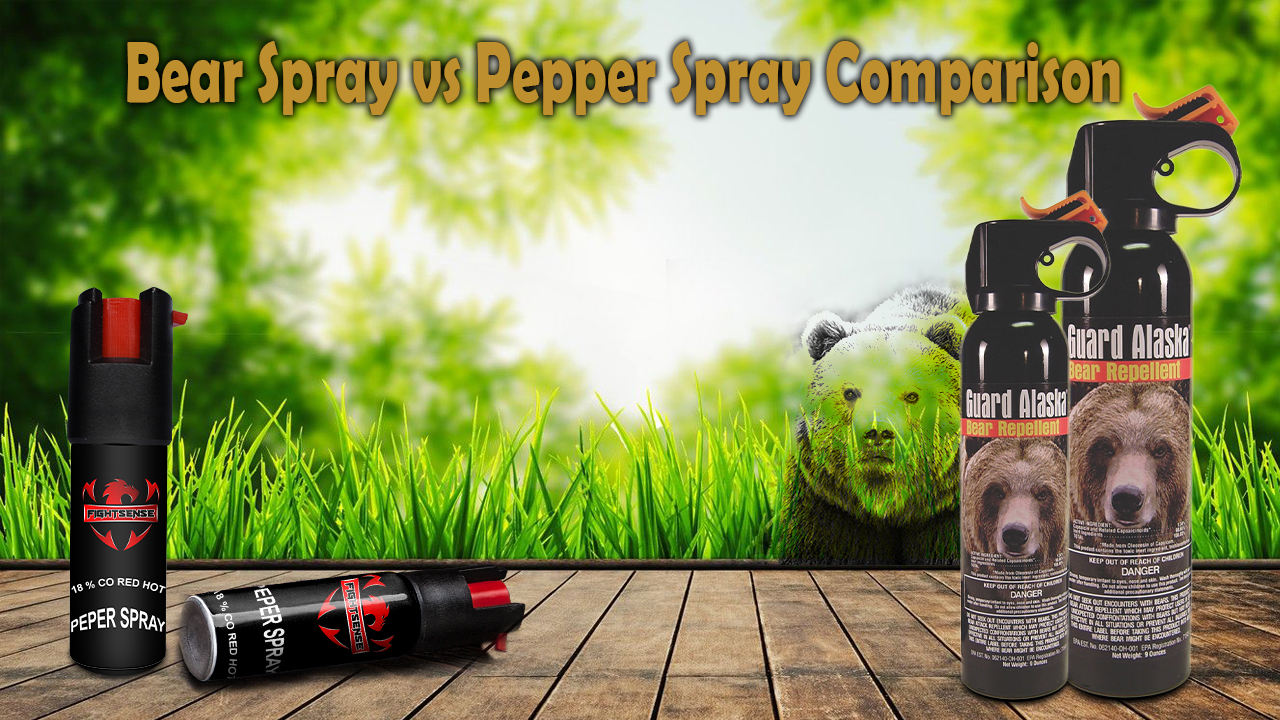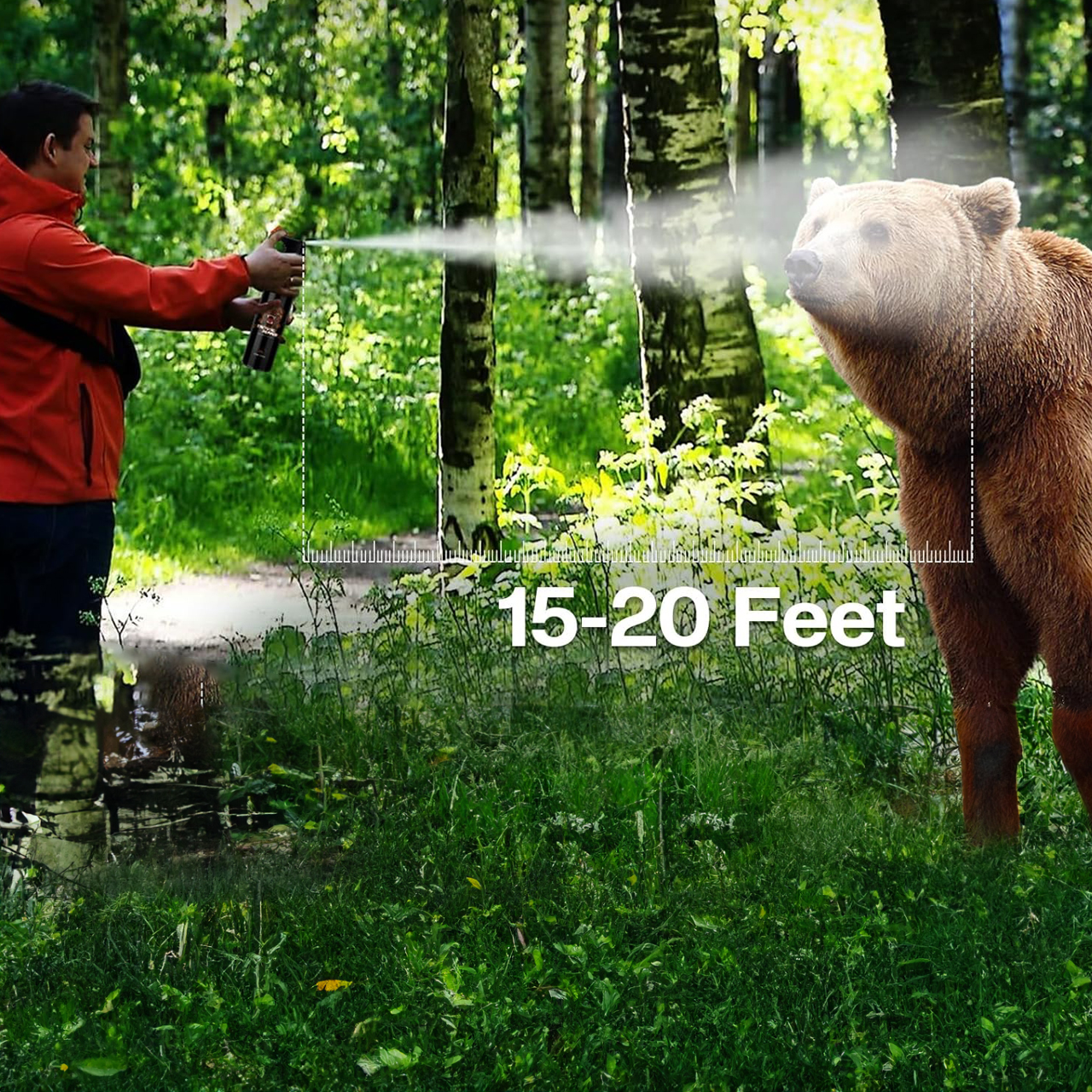Bear Spray vs Pepper Spray Comparison
20th Mar 2024

When venturing into different environments, personal safety should always be a priority. Whether you're walking through your neighborhood or hiking in bear country, having the right defensive tool can make a difference. Bear spray and pepper spray, though similar in name, serve distinct purposes and require careful consideration. This guide will help you understand the critical differences between them so you can make an informed choice.
Keynotes:
- Bear spray is for deterring bears, while pepper spray is for personal defense against human attackers.
- Both contain oleoresin capsicum, but bear spray has higher concentrations and is regulated for effectiveness against bears.
- Bear spray has a longer range (30-35 feet) with a fog-like spray, while pepper spray has a shorter range (10-25 feet) with a direct stream or cone shape.
- Bear spray is highly effective in bear encounters (90%+), while pepper spray is effective in human defense situations, causing pain and disorientation.
- Bear spray is EPA-regulated, while pepper spray is legal in all 50 states but may have local restrictions.
Why Should You Know the Differences Between Bear Spray vs Pepper Spray
It’s important to understand the differences between bear spray and pepper spray for several reasons. The purpose of carrying either is to stay safe, and each serves specific purposes to that end. They’re formulated differently, perform differently, and feature distinct weights, volumes, and ingredients. Let’s examine each individually before comparing them.
Understanding Bear Spray and Pepper Spray
Both bear spray and pepper spray contain the active ingredient oleoresin capsicum. Bear spray is specifically designed to deter aggressive or charging bears in bear country, while pepper spray is commonly used for personal defense against human attackers. Understanding the differences between these two sprays is crucial for choosing the right defense in different situations.
The Basics of Bear Spray
Bear spray, as the name suggests, is designed for use in bear country. The active ingredient, oleoresin capsicum, is derived from peppers and contains capsaicinoids, including capsaicin. The Environmental Protection Agency (EPA) regulates bear spray composition to ensure its effectiveness against bears. Bear spray typically weighs 7.9 oz to 13.2 oz and provides 5-9 seconds of continuous spray with a range of 30 feet. Always check the expiration date to ensure effectiveness.
The Basics of Pepper Spray
Pepper spray, or personal defense spray, is primarily for protection against human attackers. Like bear spray, it contains oleoresin capsicum but in varying concentrations. The most potent pepper sprays can have up to 1.4% major capsaicinoids. Pepper spray comes in smaller, portable canisters with ranges of 10-25 feet, making it convenient for everyday carry. It causes temporary blindness, intense irritation, and respiratory distress, providing a chance to escape.

How Bear Spray and Pepper Spray Work
Bear spray and pepper spray work by irritating the mucous membranes, including the eyes, nose, and throat. This results in temporary blindness, difficulty breathing, and intense coughing fits. The immediate effects allow the user to escape or seek help.
The Science Behind Bear Spray
Bear spray creates a fog-like cloud effective at a range of 30-35 feet. The capsaicinoids irritate the bear’s mucous membranes, causing temporary blindness and respiratory distress, prompting the bear to retreat.
The Science Behind Pepper Spray
Pepper spray targets human or canine attackers, causing similar irritation but with a shorter range (10-25 feet). It’s designed for quick, precise self-defense in close-range situations.
Comparative Analysis: Bear Spray vs Pepper Spray
Effectiveness in Deterring Threats
- Bear Spray: Over 90% effective in stopping bear encounters; creates a physical barrier with its long range.
- Pepper Spray: Highly effective against human attackers; causes intense pain and disorientation.
Range and Spray Patterns
| Spray | Range | Spray Pattern |
|---|---|---|
| Bear Spray | 30-35 feet | Fog-like cloud |
| Pepper Spray | 10-25 feet | Direct stream or cone-shaped |

Legal Considerations and Usage Restrictions
Bear spray is regulated by the EPA in the U.S., ensuring its effectiveness against bears. Pepper spray is legal in all 50 states but may have restrictions. Always verify local laws.
Conclusion
Understanding the differences between bear spray and pepper spray is essential for choosing the right defense mechanism. While both aim to deter threats, factors like range, spray patterns, and regulations influence their effectiveness. Stay informed, prepared, and prioritize safety.
Disclaimer
This article is for informational purposes only. Always follow local laws and regulations regarding the purchase and use of bear and pepper sprays. Misuse can result in legal consequences or harm. Use responsibly and prioritize safety.
Frequently Asked Questions
1. Can I Use Bear Spray on Humans in Emergencies?
Using bear spray on humans is not recommended. It is specifically designed for bears and may have a higher capsaicinoid concentration.
2. Is Pepper Spray Effective Against Animal Attacks?
Pepper spray may deter animals but is not as effective as sprays designed for specific animals like bears.
3. How Should I Carry Pepper or Bear Spray While Hiking?
Keep sprays accessible in a belt holster or attached to your backpack. Quick access is crucial in emergencies.
4. What Are the Main Differences in Ingredients Between Bear and Pepper Spray?
Bear spray typically contains higher concentrations of capsaicinoids, regulated for effectiveness against bears. Pepper spray concentrations vary.
5. How Can I Ensure My Safety When Carrying These Sprays?
Check expiration dates, store sprays in a cool environment, and practice using inert spray to familiarize yourself with its range and spray pattern.
